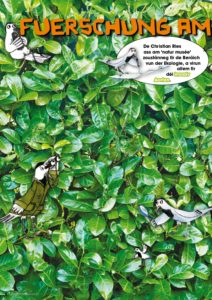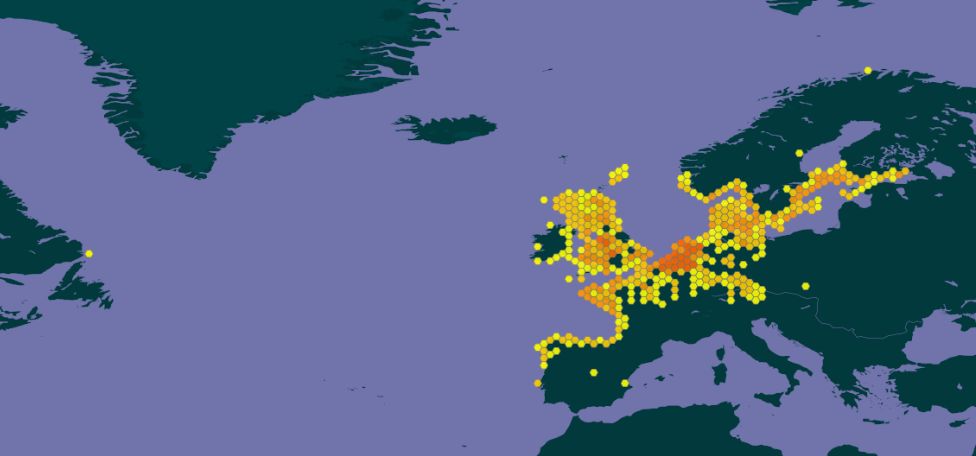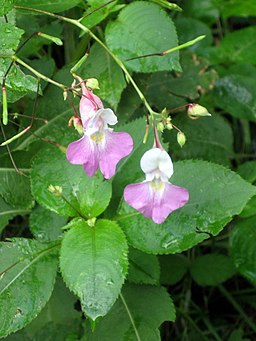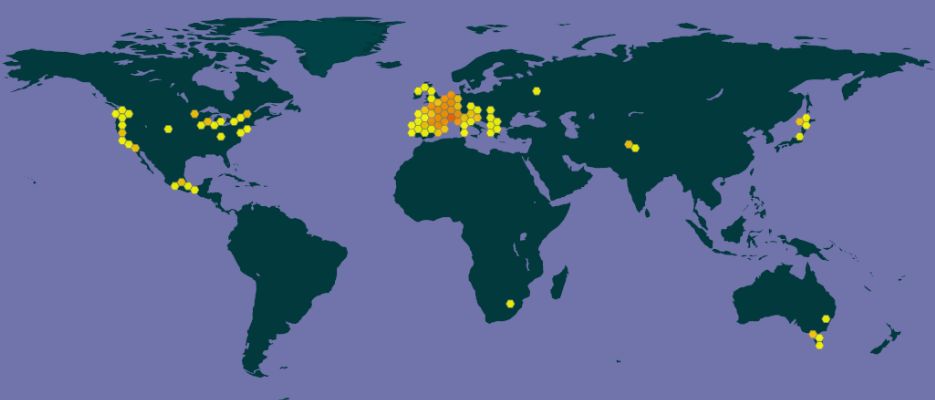 |
Danish scurvygrass |
Status LU: established. 1st record: LU & ITW 2011. |
 |
Dänescht Läffelblat |
Status Eur.: established. |
 |
Cochléaire du Danemark |
RA: ISEIA: C1. Harmonia+: 0,02 |
 |
Dänisches Löffelkraut |
Wikipedia:     | Wikispecies: | Wikispecies:  |
 |
Deens lepelblad |
Back to the list of neophytes |
Brief description
Cochlearia danica L. is native to coastal habitats in the following countries in Europe: Belgium, Denmark, United Kingdom, France, Finland, Netherlands, Ireland, Germany, Norway, Portugal, Russia, Spain and Sweden (Fekete et al. 2018: 27). This salt-tolerant coastal flowering plant is now flourishing along roads and motorways in Europe, especially under the crash barriers in the central reservation. Its success has been attributed to its ability to survive the effects of salts distributed by gritters in winter and its small seeds being spread by the high speed of cars in the fast lane. Literature data indicate a rapid spread of this species along European roads, of 62–65 km/year (Fekete et al. 2018: 28). Full of vitamin C, the Danish scurvygrass gets its name from sailors chewing it to avoid scurvy. The mauve flowers are 4-5mm in diameter (Wikipedia contributors 2019).
Status and distribution in Luxembourg
Cochlearia danica L. was first collected on 2011-05-05 in Luxembourg-Kirchberg by Jean-Claude Kirpach (MNHNL 2000-).
Since this first observation, the species has been spotted twice along the
controlled-access A6 highway near Windhof and Aire de Capellen (Krippel et al. 2018: 61-62). The
Danish scurvygrass continues to expand eastward along this highway (Krippel et al. 2020).
In a recent survey of salt-tolerant vascular plant species along roads in Luxembourg (Ehl et al. 2019), the Danish scurvygrass was not recorded, although it was expected to be found, as it was recently recorded in Trier in Germany (Hand et al. 2016) and Arlon in Belgium (Remacle 2015).
On 2018-04-11, its presence was confirmed also along the A1 motorway to Germany, more than 100,000 plants especially along the central berm, but also along the lateral strips, over several km with interruptions (Krippel et al. 2020).
In April 2021, further occurrences of the species were discovered, as white flowering patches along the A7 motorway between Mersch and Schieren: Mierscherbierg-Rouscht, after the Colmarbierg slip road and at the Schieren exit (Krippel in litt. 2021).
The general spread of Cochlearia danica has been following the pattern of roads leading from the coast to the hinterland (Brandes 2009). The Danish scurvygrass, quite common on the coasts of Western Europe, is expanding inland mainly in the north and centre of the flora territory, following the massive use of snow removal salts in winter, especially along highways (Lambinon & Verloove 2012: 270-271).
Risk assessment
ISEIA protocol
C1 (1+1+1+1). First assessed 24 January 2019 by Manou Pfeiffenschneider and Christian Ries.
Harmonia+ protocol
Overall risk score 0,02 = (Overall Invasion score 0,42 x Overall Impact score 0,07) (Ries et al. 2020).
0,42


Invasion
0,07


Impact
0,02


Risk
Worldwide distribution
Bibliography
- Brandes, D., 2009. Autobahnen als Wuchsorte und Ausbreitungswege von Ruderal- und Adventivpflanzen. Braunschweiger Naturkundliche Schriften 8(2): 373-394.
- Ehl, S., K. Mildenberger, T. Frankenberg & C. Ries, 2019. Halophytes in roadside habitats: a survey of salt-tolerant vascular plant species along roads in Luxembourg. Bulletin de la Société des naturalistes luxembourgeois 121: 37-51. [PDF 24.03 MB]
- Fekete, R., A. Mesterházy, O. Valkó & V. A. Molnár, 2018. A hitchhiker from the beach: the spread of the maritime halophyte Cochlearia danica along salted continental roads. Preslia 90: 23–37. DOI: 10.23855/preslia.2018.023
- GBIF 2020. Cochlearia danica L. in GBIF Secretariat (2019). GBIF Backbone Taxonomy. Checklist dataset https://doi.org/10.15468/39omei accessed via GBIF.org on 2020-02-28.
- Hand, R., H. Reichert, W. Bujnoch, U. Kottke & S. Caspari, 2016. Flora der Region Trier (1. & 2. Band). Verlag Michael Weyand GmbH, Trier, 1637 pp.
- Krippel, Y., T. Helminger & G. Colling, 2018. Notes floristiques. Observations faites au Luxembourg (2016-2017). Bull. Soc. Nat. luxemb. 120: 57-76. [PDF 265 KB]
- Krippel, Y., T. Helminger & G. Colling, 2020. Notes floristiques. Observations faites au Luxembourg (2018-2019). Bulletin Soc. Nat. luxemb. 122 : 29-55. [PDF 132 KB]
- Lambinon J. & F. Verloove, 2012. Nouvelle flore de la Belgique, du grand-duché de Luxembourg, du Nord de la France et des régions voisines. Sixième édition. Avec la collaboration de L. Delvosalle, B. Toussaint, D. Geerinck, I. Hoste, F. Van Rossum, B. Cornier, R. Schumacker, A. Vanderpoorten et H. Vannerom. Jardin botanique national de Belgique, Meise. CXXXIX + 1195 pp. ISBN : 9789072619884.
- MNHNL, 2000-. Cochlearia danica L. in Recorder-Lux, database on the natural heritage of the Grand Duchy of Luxembourg. Musée national d’histoire naturelle, Luxembourg. URL: https://mdata.mnhn.lu [Accessed 2019-09-05]
- MNHNL, iNaturalist & GBIF, 2019. Cochlearia danica L. in MNHNL-mdata, online portal combining species observation from Recorder-Lux, iNaturalist and GBIF. National Museum of Natural History, Luxembourg. URL: https://mdata.mnhn.lu [Accessed 2019-09-06]
- Remacle, A., 2015. L’intérêt botanique des espaces verts autoroutiers : le cas de l’autoroute E411 près d’Arlon (province de Luxembourg, Belgique). Dumortiera 107: 3-21.
- Ries, C. & Y. Krippel, 2021. First records of 56 invasive alien vascular plants in Luxembourg. Bulletin de la Société des naturalistes luxembourgeois 123: 115-127. [PDF 241 KB]
- Ries, C., Y. Krippel & M. Pfeiffenschneider, 2020. Risk assessment after the Harmonia+ protocol of invasive alien vascular plant species in Luxembourg. Bull. Soc. Nat. luxemb. 122: 197-205. [PDF 132 KB]
- Wikipedia contributors, 2019. Cochlearia danica L. in Wikipedia, The Free Encyclopedia, 16 September 2019. URL: https://en.wikipedia.org/w/index.php?title=Cochlearia_danica&oldid=916018993 [accessed 3 October 2019]
Not cited bibliography concerning our neighbouring areas
- Cochard, P.-O., 2005. Cochlearia danica L., une halophyte adventice des autoroutes. Symbioses nouvelle série 13 : 69-74. [http://pierreo.cochard.free.fr/cv_poc/Cochard_Cochlearia.pdf]
- Havrenne, A., 1995. Cochlearia danica, plante halophile nouvelle pour le Hainaut. Natura Mosana 48 : 68-69.
- Mennema, J., 1986. Cochlearia danica L. op weg naar de binnenlanden van België en West-Duitsland. Dumortiera 34-35 : 139-142.
- Olivier, J.-F., 1996. Nouvelles stations de Cochlearia danica L. près de Bruxelles. Dumortiera 66 : 1-3.
- Remacle, A., 2015. L’intérêt botanique des espaces verts autoroutiers : le cas de l’autoroute E411 près d’Arlon (province de Luxembourg, Belgique). Dumortiera 107 : 3-21.
- Robyns, J., 1978. Floristische mededelingen : Cochlearia danica te Ezemaal. Dumortiera 10 : 296.
- Zwaenepoel, A., 1994. Cochlearia danica L. als bermhalofyt langs verkeerswegen in het Vlaamse binnenland. Dumortiera 55-57 : 43-49.
Page content last updated on 2021-06-18. Last proofread by Caroline Grounds on 2019-11-12.


 Communicated on July 13th 2017 by the IAS team of DG ENV, European Commission
Communicated on July 13th 2017 by the IAS team of DG ENV, European Commission

















